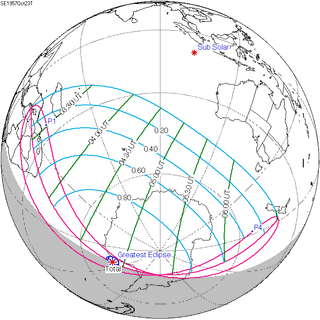Solar eclipse of January 4, 1992
| Solar eclipse of January 4, 1992 | |
|---|---|
 Map | |
| Type of eclipse | |
| Nature | Annular |
| Gamma | 0.4091 |
| Magnitude | 0.9179 |
| Maximum eclipse | |
| Duration | 701 sec (11 m 41 s) |
| Coordinates | 1°00′N 169°42′W / 1°N 169.7°W |
| Max. width of band | 340 km (210 mi) |
| Times (UTC) | |
| Greatest eclipse | 23:05:37 |
| References | |
| Saros | 141 (22 of 70) |
| Catalog # (SE5000) | 9490 |
An annular solar eclipse occurred on January 4–5, 1992. A solar eclipse occurs when the Moon passes between Earth and the Sun, thereby totally or partly obscuring the image of the Sun for a viewer on Earth. An annular solar eclipse occurs when the Moon's apparent diameter is smaller than the Sun's, blocking most of the Sun's light and causing the Sun to look like an annulus (ring). An annular eclipse appears as a partial eclipse over a region of the Earth thousands of kilometres wide.
Images

Related eclipses
Solar eclipses of 1990-1992
Each member in a semester series of solar eclipses repeats approximately every 177 days and 4 hours (a semester) at alternating nodes of the Moon's orbit.
| Solar eclipse series sets from 1990–1992 | ||||
|---|---|---|---|---|
| Ascending node | Descending node | |||
| Saros | Map | Saros | Map | |
| 121 | January 26, 1990 Annular |
126 | July 22, 1990 Total | |
| 131 | January 15, 1991 Annular |
136 From Playas del Coco | July 11, 1991 Total | |
| 141 | January 4, 1992 Annular |
146 | June 30, 1992 Total | |
| 151 | December 24, 1992 Partial |
|||
Saros 141
Solar Saros 141 repeats every 18 years, 11 days and contains 70 events. The series started with partial solar eclipse on May 19, 1613. It contains annular eclipses from August 4, 1739 through October 14, 2460. There are no total eclipses in this series. The series ends at member 70 as a partial eclipse on June 13, 2857. [1]
| Series members 17–28 occur between 1901 and 2100 | ||
|---|---|---|
| 17 | 18 | 19 |
 November 11, 1901 |
 November 22, 1919 |
 December 2, 1937 |
| 20 | 21 | 22 |
 December 14, 1955 |
 December 24, 1973 |
 January 4, 1992 |
| 23 | 24 | 25 |
 January 15, 2010 |
 January 26, 2028 |
 February 5, 2046 |
| 26 | 27 | 28 |
 February 17, 2064 |
 February 27, 2082 |
 March 10, 2100 |
Metonic series
The metonic series repeats eclipses every 19 years (6939.69 days), lasting about 5 cycles. Eclipses occur in nearly the same calendar date. In addition the octon subseries repeats 1/5 of that or every 3.8 years (1387.94 days).
| 21 eclipse events between August 12, 1942 and August 11, 2018 | ||||
|---|---|---|---|---|
| August 10-12 | May 30 | March 18 | January 4-5 | October 23-24 |
| 115 | 117 | 119 | 121 | 123 |
 August 12, 1942 |
 May 30, 1946 |
 March 18, 1950 |
 January 5, 1954 |
 October 23, 1957 |
| 125 | 127 | 129 | 131 | 133 |
 August 11, 1961 |
 May 30, 1965 |
 March 18, 1969 |
 January 4, 1973 |
 October 23, 1976 |
| 135 | 137 | 139 | 141 | 143 |
 August 10, 1980 |
 May 30, 1984 |
 March 18, 1988 |
 January 4, 1992 |
 October 24, 1995 |
| 145 | 147 | 149 | 151 | 153 |
 August 11, 1999 |
 May 31, 2003 |
 March 19, 2007 |
 January 4, 2011 |
 October 23, 2014 |
| 155 | ||||
 August 11, 2018 | ||||
Notes
- ↑ "NASA - Catalog of Solar Eclipses of Saros 141". Eclipse.gsfc.nasa.gov. Retrieved 2012-03-15.
References
- Earth visibility chart and eclipse statistics Eclipse Predictions by Fred Espenak, NASA/GSFC
Photos:
- APOD Ring of Fire Revisited, annular eclipse at sunset
External links
-
 Media related to Solar eclipse of 1992 January 4 at Wikimedia Commons
Media related to Solar eclipse of 1992 January 4 at Wikimedia Commons
